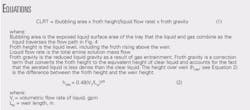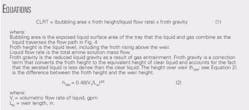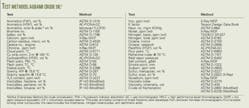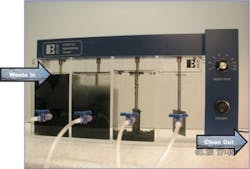The crude oil price escalation and de-escalation formula for change in API gravity may result in payment of a higher price for a crude oil as a result of the increase in API gravity, when the realizable value of the crude oil actually falls.
Most crude oils are blends from different fields. The quality is influenced by such factors as aging of production reservoirs, change in relative field production rates, and injection of significantly different quality streams such as condensate and atmospheric residue from local refineries.
Crude oil quality variation can never be eliminated and, for this reason, it may be that crude oil is generally traded based on quality available at the time of loading from the loading point. Buyers have no option but to accept the cargo according to its quality at the time of loading.
Figs. 1-3 indicate the extent of variation in API quality for some crude oils over a period of time.
Even though most grades are traded based on the quality available at loading, some grades are traded at a price that varies according to the actual API gravity compared with what is specified in the contract. The price escalates if the actual gravity at the time of loading is higher and reduced if the gravity is lower. The adjustment formula applies uniformly regardless of the extent of the variation.
Adjustment formulas
It is generally understood that the higher the API gravity, the higher the traded price of a crude oil. Some grades, depending on the General Terms and Conditions set by the oil producing company, carry a price adjustment of $0.003/bbl for every 0.1o increase or decrease in API gravity.
Some of the grades, however, carry a price adjustment of $0.04/bbl for every 0.1o increase or decrease in gravity. The adjustment formula applies uniformly across API gravity deviations, regardless of the extent of variation.
Does the increase or decrease in API gravity result in higher or lower returns? The following examples attempt to answer this question.
Example 1: The contractual formula for price adjustment with API gravity is an increase or decrease of $0.003/bbl for every 0.1o increase or decrease in API gravity. In this example, the gravity of a crude oil has increased to 35.3° API (Cargo B) from 32.9° API (Cargo A), an increase in 2.4° API. The price increase is $0.07/bbl.
Table 1 shows the change in yield pattern; Fig. 4 shows the change in realization (i.e., product value from crude oil after processing) for Cargo B – Cargo A over time.
Value realization for Cargo B is always lower than Cargo A during the pricing period. The crude price, however, was higher by $0.07/bbl.
Example 2: This case is similar to Example 1, but the extent of variation in API gravity is substantially larger. The gravity of the crude oil has increased to 48.2° API (Cargo B) from 42.6° API (Cargo A), a difference of 5.6° API. The increase in crude price is $0.17/bbl.
Table 2 shows the change in yield pattern; Fig. 5 shows the change in realization (Cargo B – Cargo A).
Value realization for Cargo B is at times lower than and at times higher than Cargo A during the pricing period, but the crude oil price is higher by $0.17/bbl.
Example 3: The contractual formula for price adjustment with API gravity is an increase or decrease of $0.04/bbl for every 0.1o increase or decrease in API gravity. We have simulated this example by blending 5% atmospheric residue in crude oil, using Haverly's Crude Assay Manager Software.
The difference between Cargo A (32.6° API) and Cargo B (31.5° API) is a decrease of 1.1° API. This implies a decrease in crude price of $0.44$/bbl.
Table 3 shows the change in yield pattern. Fig. 6 shows the change in value realization (Cargo B – Cargo A).
Value realization for Cargo B is at times lower and at times higher than Cargo A during the pricing period. During January-July 2008, the price de-escalation of $0.04/bbl for every 0.1o decrease in API was inadequate to compensate against the decrease in value realization from the crude oil.
Example 4: The contractual formula for price adjustment with API gravity is to increase or decrease by $0.04/bbl for every 0.1o increase or decrease in API gravity. We have simulated this example by blending 5% naphtha in crude oil, using the Haverly's Crude Assay Manager Software.
In this example, the crude oil gravity has increased to 33.9° API (Cargo B) from 32.6° API (Cargo A), an increase of 1.3° API, and in crude price by $0.52/bbl.
Table 4 shows the change in yield pattern; Fig. 7 shows the change in value realization (Cargo B – Cargo A).
Value realization for Cargo B is always lower than for Cargo A during the pricing period, but the crude oil price increased by $0.52/bbl.
Lesson
These examples indicate that a crude oil's realizable value may decrease with an increase in API gravity or it may decrease more than the decrease in crude oil price. The price escalation and de-escalation formula with change in API gravity may result in paying a higher price for a crude oil due to an increase in API gravity when the realizable value of the crude oil falls with an increase in API gravity.
Thus it is important to reevaluate the crude oil at regular intervals and check that the increase or decrease in price of the crude oil with a change in API gravity is in line with expectations or that the escalation, de-escalation formula is linked to the product prices.
The authors
More Oil & Gas Journal Current Issue Articles
More Oil & Gas Journal Archives Issue Articles
View Oil and Gas Articles on PennEnergy.com









